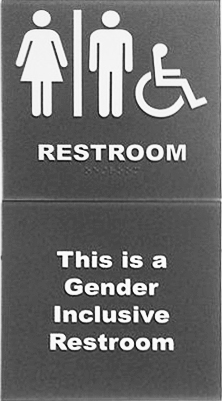
Wikimedia Commons
Following three years of advocacy from students and litigation against the state of Connecticut, Yale Law School introduced two new multi-stall gender-neutral restrooms last December.
The new bathrooms, two multi-stall units located in the basement of the Sterling Law Building, bring the count of gender-neutral stalls throughout the School to a total of 20. Before the basement bathrooms were converted to gender-neutral units last month, the Law School had a total of 14 gender-neutral single-stall units — four of which were added in August 2018 — according to Associate Dean of the Law School Mike Thompson. Last week, OutLaws — an organization for lesbian, gay, bisexual, transgender and queer members of the Law School community — held an event to celebrate the multiyear effort coming to fruition.
“I think it’s a really positive step,” said Hannah Hussey LAW ’20, co-president of OutLaws. “Obviously gender equity is multifaceted, and this is one piece among many, but I think it sends a really strong message that YLS recognizes that gender is not always a binary.”
According to Hussey, Yale Law students have long advocated for more all-gender bathrooms, beginning with efforts three years ago. Hussey explained that Connecticut building code requires a “minimum number of bathrooms that are required in buildings for women and men, separately,” meaning that restrooms available for use by all genders do not count toward the number of restrooms needed for compliance.
The school requested a building code modification in December 2016, which was then rejected by the state’s deputy building inspector. The codes and standards committee upheld the inspector’s decision in March 2017. When the Connecticut Codes and Standards Committee routinely solicited feedback from the public that month, OutLaws convinced over 25 Connecticut organizations to support their proposed amendments to the Connecticut Plumbing Code, including clauses to count gender-neutral bathrooms towards the total number required in a building. Three months later, the University filed an administrative appeal in the State of Connecticut Superior Court, the New Haven Register reported.
In the University’s June 2017 appeal, Yale argued that the construction of more bathrooms would negatively impact the architectural integrity of the almost century–old building and would be impossible due to space constraints. It also wrote that a shift to gender neutral designation for bathrooms at the School would “facilitate quick access to a bathroom within the building for persons of all gender identities.”
In June 2017, Reuters reported that a spokeswoman for then-Connecticut Gov. Dannel Malloy would seek to grant Yale’s request.
“This was a great collaborative effort led by our students that had strong community support,” Associate Dean Thompson said. “The response has been very positive and we are pleased to have been able to complete the project this academic year.”
According to YLS Associate Dean for Student Affairs Ellen Cosgrove, the school aims to create an environment where all community members feel welcome and secure. The bathrooms “were an important step in that regard,” she said. Cosgrove added that the effort to bring all-gender multi-stall restrooms is “still in its early stages” and required community discussions that considered religious and cultural differences.
Hussey praised the efforts of the YLS students who “tirelessly advocated for school facilities to reflect the fact that gender does not fall on a binary.”
“Bathrooms, among other places, have been a location for discomfort, harassment and violence against transgender and gender nonconforming people,” Hussey said. “In light of that, OutLaws is so appreciative of all the students … who worked to take this step forward for the law school community.”
Sterling Law Building is located at 127 Wall Street.
Asha Prihar | asha.prihar@yale.edu .







